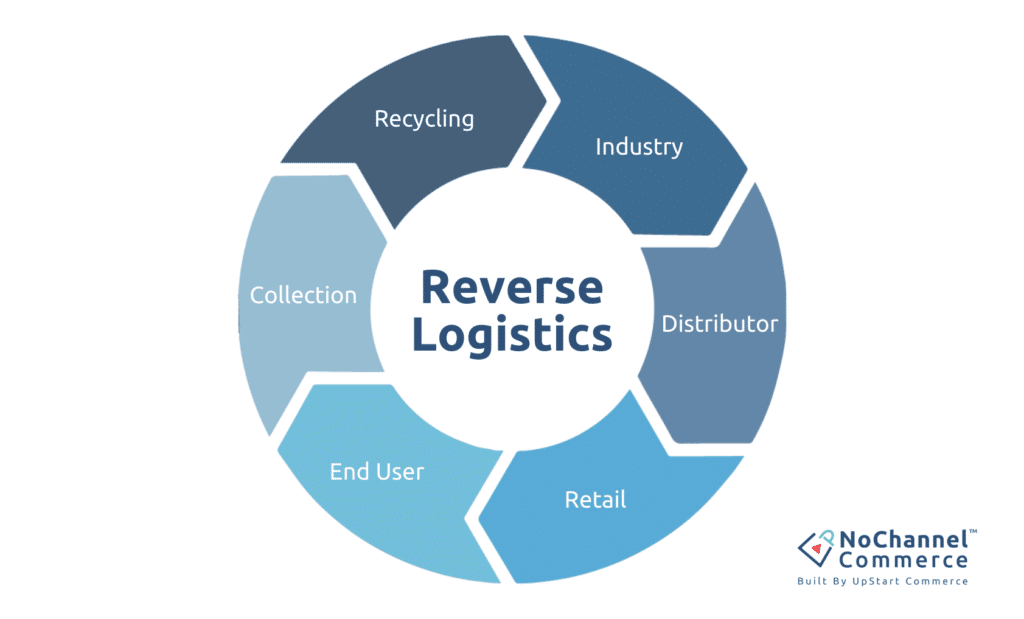As we step into October 2023, the ecommerce industry is undergoing many changes, making agility and adaptability non-negotiable for retailers. In order to plan for success in the final quarter of 2023, including the upcoming holiday season, it is important to take a look at ways to improve your ecommerce strategy. Preparing for the holiday season in retail requires a willingness to adapt and explore new options to meet consumer demands. Retailers can leverage reverse logistics, mobile-first websites, AI for hyper-personalization, social commerce, and more to create user experiences that build loyal customers.
Here’s an in-depth look at 5 ecommerce tips to ensure your retail business stays ahead of the curve:
1. Leveraging Reverse Logistics For Increased Cost Savings
What is Reverse Logistics?
Reverse logistics means managing the journey of products that have been returned to a company. This process starts with the customer and goes backward through the supply chain to the seller and manufacturer. Optimizing the reverse logistics process helps to recover value. The holistic returns process not only includes many time-consuming touchpoints but is also costly for businesses. Retailers know that successfully managing returns is a crucial aspect of having a successful ecommerce business.

How to Strategize Reverse Logistics in Ecommerce
Ecommerce retailers should prioritize preventing avoidable returns. To do this, first analyze the most frequent reasons for returns. Utilize surveys, customer feedback, and ratings and reviews to understand common pain points and issues customers face. Once the top reasons for returns have been identified, work on problem-solving these issues and finding solutions that not only help your company but also satisfy customers. Listening to customer feedback builds consumer trust.
As smartphones remain a constant source of ecommerce traffic and younger generations enter the age of shopping, the importance of mobile shopping optimization becomes self-evident. A majority of shoppers now prefer mobile-designed interfaces for their convenience and speed. When a website is not designed with mobile users in mind, shoppers are likely to bounce from the site in search of a competitor’s website that is easier to navigate.
How to Take a Mobile-First Approach in Ecommerce
Your website should not just be mobile-friendly but mobile-optimized. This includes reducing page load times, offering an intuitive UI/UX, and simplifying the checkout process. Implementing a Progressive Web App (PWA) can provide a seamless, app-like experience making it a future-proof strategy.
3. Leverage AI for Hyper-Personalization
Why AI Matters in Modern Retail
In today’s competitive ecommerce space, providing a personalized shopping experience is key for customer retention and brand loyalty. With AI and machine learning advancements, customization goes beyond merely suggesting products based on browsing history.
Implementing AI for Consumer Personalization
AI algorithms can analyze consumer behavior, preferences, and even mood, and then tailor your on-page product recommendations, email marketing, and advertising campaigns accordingly. This advanced level of personalization helps your offers resonate with potential buyers and enhances customer loyalty.
4. The Consistent Rise of Social Commerce in 2023
Social media platforms are not just for socializing anymore; they’ve become viable sales channels that enable direct purchasing right from the platform. With social commerce, customers can discover, research, and purchase products without leaving their preferred social media platform. It often involves features like shoppable posts, in-app checkout options, user reviews and recommendations, and the integration of social media with ecommerce websites.
Using Social Commerce to Make Sales
Integrate your ecommerce platform with social media networks like TikTok and Instagram to offer features like ‘Shop’ and ‘Checkout.’ Social commerce is not an alternative but a complementary sales channel that capitalizes on impulse buying and customer discovery.
5. Supply Chain Optimization via IoT
The Internet of Things (IoT) offers an unparalleled advantage in supply chain management by providing real-time data on stock levels, transportation conditions, and delivery timelines.
Using IoT for Supply Chain Optimization
Deploy IoT sensors throughout your supply chain to receive real-time notifications and optimize stock management. By doing this, you not only improve operational efficiency but also guarantee a higher level of customer satisfaction due to better inventory management and faster deliveries.
Adapting to the Modern Ecommerce Landscape
To thrive in ecommerce and set the stage for a successful final quarter, especially with the holiday season approaching, it’s crucial to continually refine and enhance your ecommerce strategy. Preparing for the holiday retail rush demands a proactive approach, one that embraces change and embraces innovative solutions to meet customer expectations. By harnessing the power of reverse logistics, adopting mobile-first design, harnessing AI for hyper-personalization, embracing social commerce, and more, retailers can not only adapt but also thrive, creating exceptional user experiences that foster customer loyalty.
